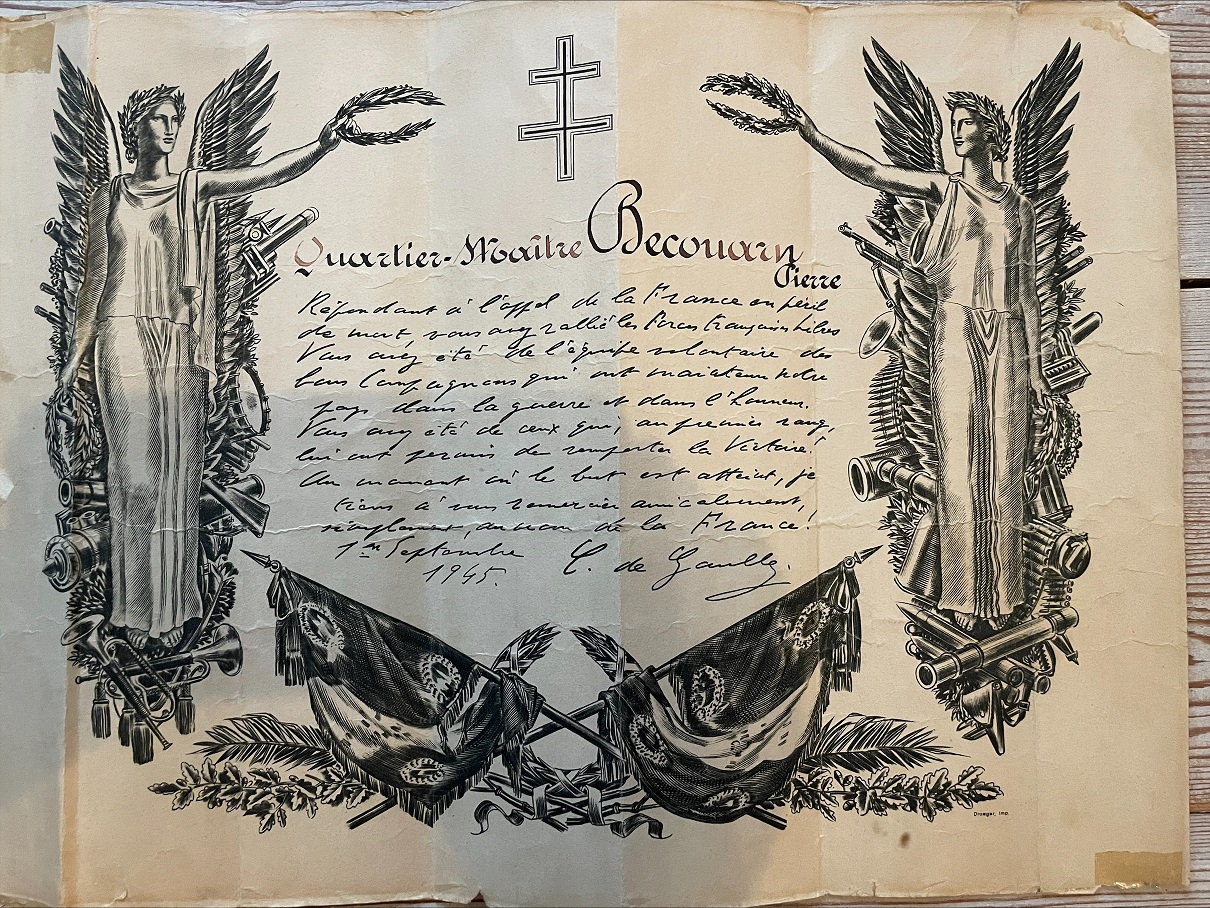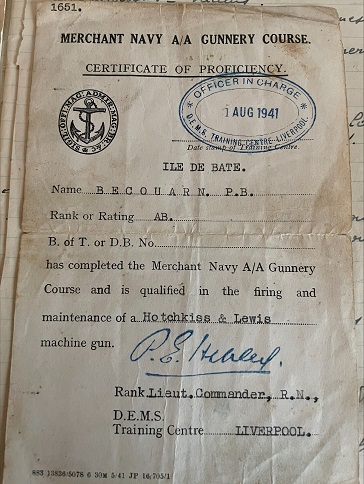 Pierre Becouarn - Forces navales françaises libres
Pierre Becouarn - Forces navales françaises libres



Les paragraphes de cette page sont en version brezhoneg, français, also available in english. (Cliquez pour choisir)
Stumm brezhonek
Ganet e oa bet Per e Sant-Edern e Plouha e 1923. E mezheven1940, d'an oad a 16 vloaz, e oa ezel eus skipailh ul lestr glaou a glaske da gentañ kemer repuidi eus Cherbourg met pa errujont er porzh
e weljont
marc'htanerien alaman o tiflukañ war ar c'hae … A-benn ar fin ez eas al lestr war-zu Barry e Su-Kembre.
Gallout a rae mont en-dro en ur Vreizh renet gant an Alamaned
met dibabet en deus ar Forces Françaises Libres. D'an 11 a viz Gwengolo 1940 ez eas Pierre e Morlu marc'hadour ar Forces Navales Françaises Libres (FNFL).
Servijañ a reas war al listri Capo-Olmo hag Ile of Bate (Enez-Vaz) e-touez reoù all. Ur “gunner” a oa anezhañ (sellit ouzh an testeni barregezh da dennañ ha da zerc'hel mindrailherezed Hotchkiss ha Lewis,
roet dezhañ e miz Eost 1941).
D'ar c'houlz-se e veze o vordeiñ etre Breizh-Veur hag Afrika. Un tamm diwezhatoc'h e tivizas mont da servij war ar c'honvoiennoù treuzatlantel, al linennoù Amerika-Breizh-Veur dañjerus-kenañ,
just a-raok ma voe torpedet an Ile of Bate (Enez-Vaz) e miz Meurzh 1942 e-tal aod al Liberia. Kenderc'hel a reas da vont war vor betek miz Du 1943.
Gloazet e voe gant tarzhadenn ur min pa voe e lestr o tegouezhout e porzh Oban e Bro-Skos, un eil gloazadur goude ar c'hentañ bet tapet war ar Capo Olmo e 1941.
Chom a reas e Londrez o labourat evel klañvdiour en ospital evit ar Français Libres hag an Navy. Ret eo merkañ e oa dañjerus-kenañ ar merdeiñ en Norzh-Atlantel pa rae Pierre an treuzioù,
ouzhpenn un daouzek gwech. Ret e oa da Vro-Saoz enporzhiañ muioc'h eget ur milion a donennadoù bep sizhun evit chom bev ha derc'hel ar stourm. War-dro 30 000 den a varvas e-touez an 90 000 a vordoe er c'honvoiennoù. 3500 lestr kenwerzh a voe kollet. Koulskoude e voe trec'h ar Gevredidi tamm-ha-tamm, o vezañ trec'h war an argaderien-gorre alaman e dibenn 1942 ha war an U-boat
e kreiz 1943, daoust ma kendalc'has al listri-pluj alaman d'ober o reuz betek fin ar brezel. Ar morlu marc'hadour eus an FNFL a oa 153 lestr ennañ e penn-kentañ 1943.
66 lestr nemetken a
oa dindan banniel ar groaz Loren. 29 anezho a voe kaset d'ar strad (tost an hanter !). Ar re all o doa skipailhoù mesk-ha-mesk (Frañsizien ha Saozon). War ar bagoù-se eo e servijas Pierre.
Siwazh, Jean, breur da Ber hag a oa 7 vloaz koshoc'h egetañ, a varvas d'an 13 a viz Here 1942 e-tal aodoù Casablanca pa voe beuzet e-bourzh al
lestr-spluj Sidi-Berruch (1500 tonennad, 92m ha 65 skipailh) kaset d'ar strad gant ur bombezer amerikan. Seul washoc'h a se an taol kriz-mañ pa c'hoarvezas goude an arsav-brezel sinet d'an 11,
o lakaat un termen da emgannoù an oberiadenn Torch e Norzh-Afrika. Ne zlefe ket bezañ sellet ouzh al lestr-spluj evel ouzh unan eus morlu Vichy. Brezel eo !
Goude ar brezel e teuas Per en-dro da Plouha da heuliañ obidoù e vreur met ne voe ket degemeret mat. “Gwisket em boa ma dilhad soudard ha tud a oa ha ne blije ket dezho kement-se.
Disrann a lakaas er familh” eme Per da Kate Helyer en un atersadenn e 2010. Kreñv e oa c'hoazh ar gounnar e Breizh war lerc'h tagadenn ar flodad gall e porzh Mers-El-Kebir, e-kichen Oran,
e miz Gouere 1940 gant kevredidi an derc'hent. Mervel a reas 1300 martolod en o listri eoriet ha dic'hallus da stourm pe da dec'hout (ar pep brasañ anezho el lestr-hobregonet Le Bretagne ).
Dimezet gant ur wreg saoz, Kathleen Reilly e 1943, Per a reas e annez e Bro-Saoz. Labourat a reas e kegin ar Savoye e Londrez, goude-se e klub Albemarle ma teuas da vezañ rener.
Da 82 vloaz e tivizas kemer e retred, araok-ar-mare emezañ gant fent. Aet eo d'an Anaon en Ilfracombe, e Devon, e 2014, e dud kar en e gichen.
Skrivet eo bet ar pennad-mañ gant sikour Paul Becouarn, mab-bihan da Ber o chom e Devon, hag en deus kinniget ar skeudennoù. Tennet hon eus ivez gounid eus un atersadenn
gant Kate Helyer er Journal of North-Devon (26 a viz Eost 2010). Pouezañ a reas Kate Helyer war an tu “strobinellus” / "Charmed life" e buhez “Brave Pierre” dre m'en doa tec'het a-zirak an ankou meur a wech. Kalz a ditouroù a zo bet kavet ivez war lec’hienn ar Français Libres, www.francaislibres.net.
Deroet eo bet al lejion a enor da Ber e miz Kerzu 2015.
Version française
Pierre est né à Saint-Edern en Plouha en 1923. En juin 1940, à 16 ans, il fait partie de l'équipage d'un charbonnier qui tente d'abord de recueillir des réfugiés de Cherbourg mais des motocyclistes allemands
apparurent sur le quai lorsqu'ils arrivaient à l'entrée du port... Finalement le navire fit route vers Barry dans le sud du Pays de Galles. Il aurait pu retourner en Bretagne sous domination allemande mais
il choisit les Forces françaises libres. Le 11 septembre 1940, Pierre s'engage dans la marine marchande des Forces Navales Françaises Libres (FNFL).
Il embarqua à bord du Capo-Olmo et de l'île de Bate (Ile de Batz) parmi d'autres navires. C'est lorqu'il était en service sur l'Ile de Bate que Pierre reçut son certificat d'aptitude au tir et à l'entretien des mitrailleuses Hotchkiss et Lewis, délivré en août 1941 ;
ce qui faisait de lui un « canonnier ». Il est d'abord envoyé en Afrique récupérer des navires à Freetown au Libéria. Puis il décide de servir sur les lignes transatlantiques, celles des
très dangereux convois américano-britanniques, juste avant que l'Ile of Bate ne soit torpillé en mars 1942 au large du Libéria. Il continue à naviguer jusqu'en novembre 1943.
Blessé par l'explosion d'une mine lors de l'entrée de son navire dans le port d'Oban en Ecosse, une seconde blessure après une première sur le Capo Olmo en 1941,
il est affecté à Londres comme infirmier dans un hôpital de la France Libre et de la Navy. Il faut noter que la navigation dans l'Atlantique Nord était particulièrement dangereuse lorsque Pierre effectua ses
nombreuses traversées, plus d'une douzaine. L'Angleterre avait besoin d'importer plus d'un million de tonnes de matériel par semaine pour survivre et continuer le combat.
Parmi les 90 000 hommes qui prirent part aux convois, environ 30 000 périrent. 3 500 navires marchands furent perdus. Les Alliés prirent cependant peu à peu le dessus, neutralisant les navires
de surface allemands à la fin de 1942 et les U-Boote à la mi-1943, mais les pertes dues aux sous-marins allemands continuèrent jusqu'à la fin de la guerre. La marine marchande des FNFL comptait 153 navires au début de 1943. Seuls 66 navires arboraient le pavillon de la Croix de Lorraine. 29 d'entre eux furent coulés (presque la moitié !). Les autres avaient des équipages mixtes. C'est sur ces bateaux que Pierre servit.
Malheureusement, Jean, le frère de Pierre, de 7 ans son aîné, décèda le 13 novembre 1942 au large de Casablanca à bord du sous-marin Sidi-Berruch
(1500 tonnes, 92 m et 65 hommes d'équipage), coulé par un bombardier américain. Ce drame est d'autant plus tragique qu'il survint après le cessez-le-feu signé le 11, mettant une fin rapide aux combats de l'opération
Torch en Afrique du Nord. Le sous-marin n'aurait pas dû être considéré comme appartenant encore à la Marine de Vichy. C'est la guerre !
Après la guerre, Pierre revint à Plouha pour assister aux funérailles de son frère mais il ne se sentit pas le bienvenu. « Je portais mon uniforme et il y avait des gens qui n'aimaient pas ça. « Cela a créé une rupture dans la famille », a confié Pierre à Kate Helyer dans une interview en 2010. Le ressentiment était encore fort en Bretagne après l’attaque de la flotte française dans le port de Mers-El-Kebir près d’Oran en juillet 1940 où 1300 marins périrent dans des navires ancrés et incapables de combattre ou de fuir (la plupart d’entre eux à bord du cuirassé Bretagne). Marié à une anglaise, Kathleen Reilly en 1943, Pierre s’est installé en Angleterre. Il a travaillé dans les cuisines du Savoye à Londres, puis au club Albemarle dont il est finalement devenu le directeur.
À 82 ans, il décida de prendre ce qu’il a appelé une retraite anticipée. Il est décédé à Ilfracombe dans le Devon en 2014 entouré de ses proches.
Cet article a été écrit avec l’aide de Paul Becouarn, petit-fils de Pierre vivant dans le Devon, qui a fourni les illustrations. Nous avons également bénéficié d'une interview de Pierre par Kate Helyer dans le Journal of North-Devon (26 août 2010) insistant sur le côté « charming » de la vie de « Brave Pierre » qui a échappé plusieurs fois à la mort. De nombreuses informations sont également disponibles sur le site des Français Libres, www.francaislibres.net.
Pierre a été décoré de la légion d'honneur en juin 2015.
English version
Pierre was born at Saint-Edern in Plouha in 1923. In June 1940, aged 16, he was member of the crew aboard a coal ship which first attempted to pick up refugees from Cherbourg but German motorcyclists
appeared on the dock when arriving at the entrance of the harbour. Finally the ship headed to Barry in South-Wales. He could have gone back to a German-rule Brittany but he chose
the Free French Forces. The 11th of September 1940, Pierre joined the Merchant Marine of the Forces Navales Françaises Libres (FNFL). He served on board the Capo-Olmo and the "Ile of Bate" amongst other merchant ships.
He was a member of the crew of the Ile of Bate when he obtained his certificate of capacity to firing and maintening Hotchkiss and Lewis machine guns in August 1941; which made a “gunner” of him. At that time, he sailed between
Britain and Africa. A little later he decided to serve on transatlantic lines, the highly dangerous America-Britain convoys, happily
just before the Ile of Bate was torpedoed in March 1942 off the coast of Liberia. He kept on sailing up to November 1943. Wounded by a mine when his ship entered Oban Harbour in Scotland,
a second wound after a first one on the Capo Olmo in 1941, he staid in London working as a hospital nurse for the Free Frenchs and the Navy.
It is worth noting that the navigation in the North-Atlantic was particularly dangerous when Pierre did the crossings, more than a dozen times.
Britain required more than a million tons of imported material per week in order to survive and fight. Amongst the 90 000 men who worked in the convoys about 30 000 perished. 3500 merchant vessels were lost. However, Allies gradually gained the upper hand, overcoming German surface-raiders by the end of 1942 and defeating the U-boats by mid-1943, though losses due to German submarines continued until the war's end. The merchant marine of the FNFL was of 153 ships at the beginning of 1943. Only 66 ships lied the flag with the Cross of Lorraine. 29 of them were sunk (almost the half!). The others had mixed crews. It is on these boats that Pierre served.
Sadly, Jean, Pierre's brother who was older than Pierre by 7 years, died on the 13th of November 1942 off the coast of Casablanca when his sub-marine Sidi-Berruch (1500 tons, 92m and 65 crewmen) was sunk by an american bombarder. This was particularly tragic as it happened after the cease-fire signed on the 11th , ending the fights of the Torch operation in North-Africa. The sub-marine should not have been considered as still belonging to the Vichy Navy. That's war!
After the war, Pierre came back to Plouha to attend his brother's funerals but he was not welcome. “I wore my uniform and there were people who did not like that. It made a rift in the family” Pierre told Kate Helyer in an interview in 2010.
The resentment was still strong in Brittany after the attack of the french fleet in the harbour of Mers-El-Kebir near Oran in July 1940 where 1300 sailors died in ships anchored and unable to fight or escape (most of them in the battleship Bretagne).
Married with an english wife, Kathleen Reilly in 1943, Pierre made his home in England. He worked in the kitchens of The Savoye in London, then at the Albemarle club where he eventually became manager. At 82 he decided to take what he called an early retirement. He died at Ilfracombe in Devon, in 2014, surrounded by his loved ones.
This article has been written with the help of Paul Becouarn, Pierre's grand-son living in Devon, who kindly provided illustrations. We have also benefited from an interview of Pierre by Kate Helyer in the Journal of North-Devon (26th of August 2010) insisting on the “charming” aspect of “Brave Pierre”'s life as he escaped death several times. Many informations have also been available from the website of the Français Libres, www.francaislibres.net.
Pierre was awarded the legion of honour in June 2015.
 Pierre Becouarn - Forces navales françaises libres
Pierre Becouarn - Forces navales françaises libres


